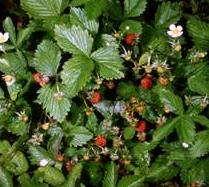Strawberry, any plant of the genus Fragaria of the family Rosaceae (rose family), low herbaceous perennials with edible red fruits, native to temperate and mountainous tropical regions. The European everbearing strawberry (F. vesca) is the only species that does not put out the stolons typical of this easily propagated genus. It has been cultivated sporadically since pre-Christian times but intensively only since the 15th cent. The common strawberry, grown in many varieties in both Europe and America, is Fragaria × Ananassa, the result of the hybridization of F. chiloensis, believed to be indigenous to Chile and to the mountains of W North America, with the wild strawberry (F. virginiana) of E North America. Both species were introduced to Europe by New World explorers; the large French industry grew from a single common strawberry plant. Strawberries are sold fresh, frozen, or in preserves and are used in confectionery and for flavoring. Strawberries are classified in the division Magnoliophyta, class Magnoliopsida, order Rosales, family Rosaceae.
Online Encyclopedia Blog For Kid's Research In Sciences, Health, Environment and Technology
Popular Posts
-
Plant Cell Plant cells contain a variety of membrane-bound structures called organelles. These include a nucleus that carries genetic...
-
All flowers share several basic features. Sepals, protective coverings that are closed over the bud before it blooms, are the outermost flow...
-
Archaea or Archaebacteria, common name for a group of one-celled organisms, many of which do not require oxygen or sunlight to live. Before ...
-
Insectivorous Plants, also carnivorous plants, plants that gain some of their nutrition from animals, especially insects, captured by the pl...
-
Algae, diverse group of simple, plantlike organisms. Like plants, most algae use the energy of sunlight to make their own food, a proces...




